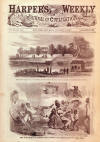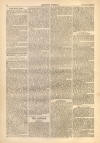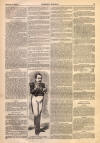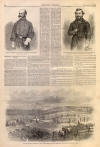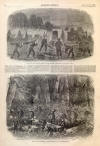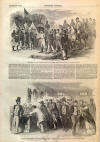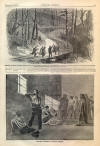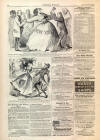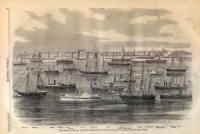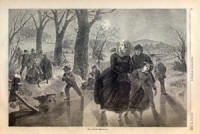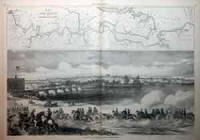Civil War Prisoners
|
|
This Site:
|
JANUARY 18, 1862.] HARPER'S WEEKLY. 39 THE ARMY ON THE POTOMAC—BRINGING IN REBEL PRISONERS.—[SKETCHED BY OUR SPECIAL ARTIST.](Previous Page) a Congress of Confederate States. In the centre of the Square is the beautiful equestrian statue of Washington, looking as calm and serene and commanding as if the city which he overlooks was not the centre and hot-bed of the foulest treason that ever showed itself in the light of day. The pedestal is designed for eight other statues of distinguished Virginians, but three of which have yet been put in their places. These are Jefferson, Henry, and Mason—not the arrogant, self-conceited blockhead who recently represented the State in the Senate at Washington, and has now gone seeking recognition at London as the diplomatic representative of secessiondom, but a far purer, wiser, and more patriotic namesake of his. Here also is a small statue of Henry Clay. Richmond has really but one business thoroughfare. That is Main Street. Most of the hotels, banks, newspaper offices, and stores are located on it. It extends northward into the open country, and southeastward to a suburb called Rocketts. In this latter section of it are situated some of the tobacco warehouses where our Union prisoners are now confined. These are large old brick edifices, of mouldy, dilapidated appearance. They stand three together on one side of the street—which here is of a most dingy character—and two nearly opposite. Those on the north side are overlooked by the bluffs in which Church Hill here terminates, and which supply gravel for the city, while those on the south side of the street have the James River and Kanawha Canal, and the river itself immediately in their rear. Near the summit of the elevation known as Church Hill is a large, old-fashioned brick building known as the alms-house. It has been converted from its original purpose, and now serves as a hospital for our sick and wounded. Sisters of Charity come and go, untiring angels of consolation, and the hearse is kept in constant requisition, so great is the mortality that prevails here. Many of the private houses in the vicinity are also converted into temporary hospitals. As a general thing, the former residents of this part of the city have gone elsewhere since the location of the hospitals here; and now on every tenth house .or more you see waving a little dirty, whitish-yellow flag, denoting a lazaretto. The Odd Fellows' Hall, on Broad Street, is also used as a general hospital. On the most commanding part of Church Hill still stands, in good preservation too, the church in which Patrick Henry made the famous speech at the commencement of the Revolutionary struggle, where he used that memorable and oft-quoted phrase, "Give me liberty, or give me death!" Around the church are the graves of the last generation of the people of Richmond, and I was no little disgusted to observe that few of the head-stones had escaped the profane Vandalism of some scoundrels, who, as a proof of their wit, cut the figure " 1" before the figures recording the ages of the deceased, making it appear that those who rested here from their labors had enjoyed incredibly patriarchal length of years. Between this hill and the rickety suburb known as Rocketts there is a large encampment, and I believe there are also batteries here, for the defense of the river. I know that there certainly are batteries on the bluffs, above and beyond Rocketts. Near here the few steamers and sailing craft that used to trade to Richmond had their mooring-places, and here also the James River and Kanawha Canal has its southern outlet into the river. This is a great work of internal improvement, so far as the design is concerned; but, unfortunately for Virginia, her execution does not keep pace with her plans, and the canal, though open for many years, does not come within a long distance of the Kanawha River, which it was intended to tap. If it ever will do so, it must be after secession is crushed and the Union restored. Richmond is not, as seems erroneously to be considered, garrisoned by a large army. There are only camps of instruction maintained here. The recruits are sent for drill and equipment, and when they are considered tolerable in those respects they are forwarded to other points. APPLYING FOR PASSES AT THE OFFICE OF THE PROVOST MARSHAL AT ST. LOUIS.--[SKETCHED BY MR. ALEXANDER SIMPLOT.] 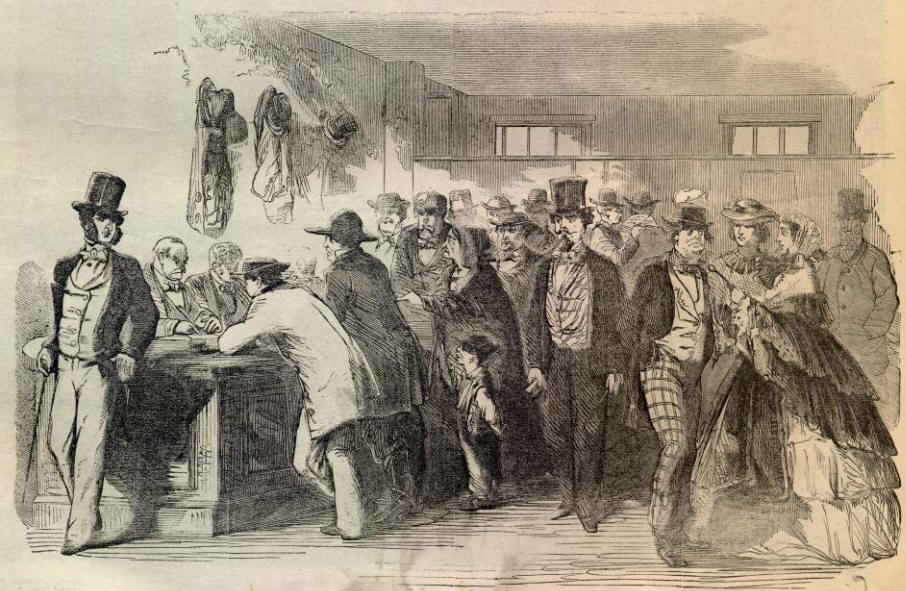 |
||||||||||||||||||||||
|
|
||
|
|
Site Copyright 2003-2018 Son of the South. For Questions or comments about this collection, contact paul@sonofthesouth.net |
|
|
Are you Scared and Confused? Read My Snake Story, a story of hope and encouragement, to help you face your fears. |
||
